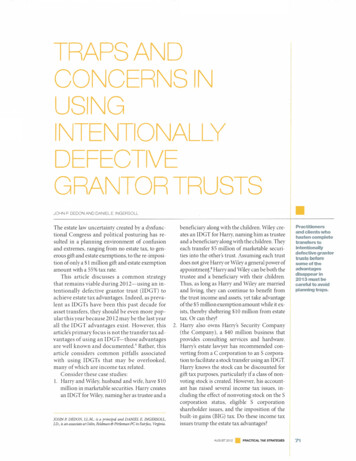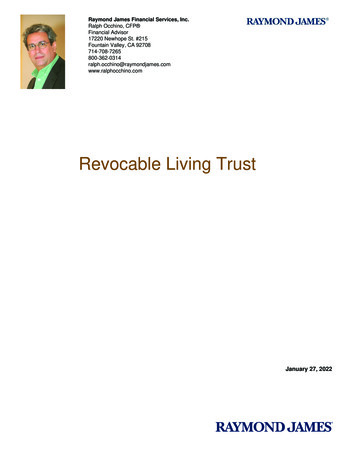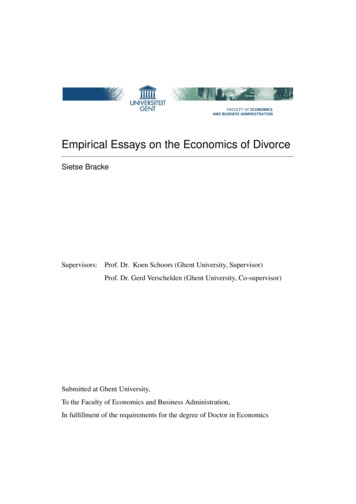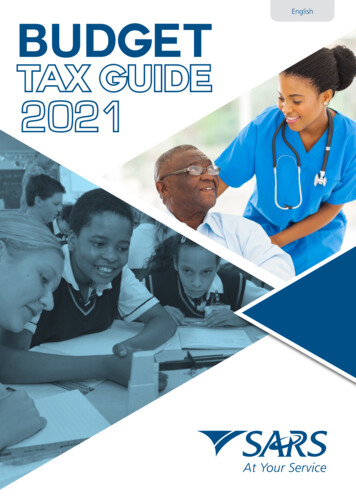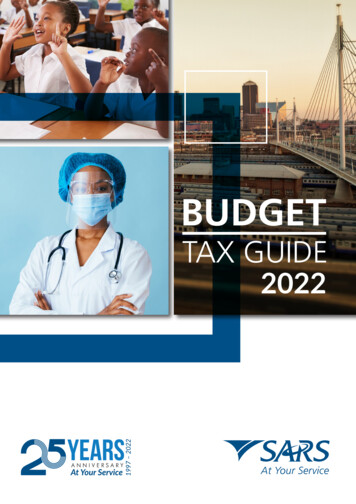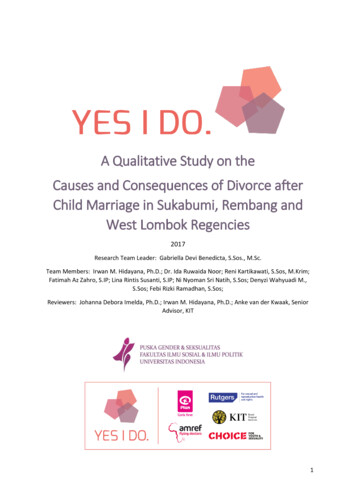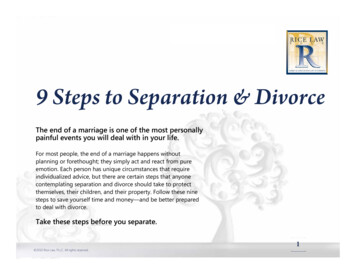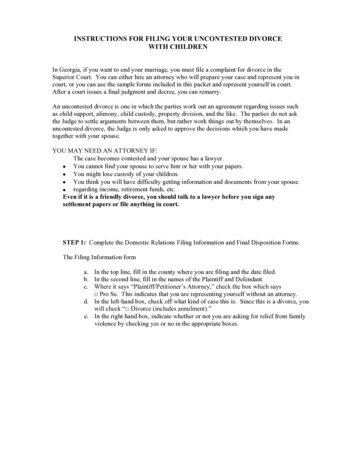
Transcription
Presenting a live 90-minute webinar with interactive Q&AGrantor Trusts After Divorce: Tax Reform,Fiduciary Challenges, and MinimizingTax for Trust Transfers to Former SpouseGift Tax Exemption on Divorce Transfers, Grantor Trust Rules, Gift-Splitting and Income Tax RulesWEDNESDAY, FEBRUARY 14, 20181pm Eastern 12pm Central 11am Mountain 10am PacificToday’s faculty features:Audrey Young, Senior Manager, Private Client Services, RSM US, BostonKenneth A. Goldstein, Partner, Horwood Marcus & Berk, ChicagoThe audio portion of the conference may be accessed via the telephone or by using your computer'sspeakers. Please refer to the instructions emailed to registrants for additional information. If youhave any questions, please contact Customer Service at 1-800-926-7926 ext. 1.NOTE: If you are seeking CPE credit, you must listen via your computer — phone listening is nolonger permitted.
Tips for Optimal QualityFOR LIVE EVENT ONLYSound QualityIf you are listening via your computer speakers, please note that the qualityof your sound will vary depending on the speed and quality of your internet connection.If the sound quality is not satisfactory, you may listen via the phone: dial1-866-961-9091 and enter your PIN when prompted. Otherwise, pleasesend us a chat or e-mail sound@straffordpub.com immediately so we can address theproblem.If you dialed in and have any difficulties during the call, press *0 for assistance.NOTE: If you are seeking CPE credit, you must listen via your computer — phonelistening is no longer permitted.Viewing QualityTo maximize your screen, press the F11 key on your keyboard. To exit full screen,press the F11 key again.
Continuing Education CreditsFOR LIVE EVENT ONLYIn order for us to process your continuing education credit, you must confirm yourparticipation in this webinar by completing and submitting the AttendanceAffirmation/Evaluation after the webinar.A link to the Attendance Affirmation/Evaluation will be in the thank you email that youwill receive immediately following the program.For CPE credits, attendees must participate until the end of the Q&A session andrespond to five prompts during the program plus a single verification code. In addition,you must confirm your participation by completing and submitting an AttendanceAffirmation/Evaluation after the webinar.For additional information about continuing education, call us at 1-800-926-7926 ext. 2.
Program MaterialsFOR LIVE EVENT ONLYIf you have not printed the conference materials for this program, pleasecomplete the following steps: Click on the symbol next to “Conference Materials” in the middle of the lefthand column on your screen. Click on the tab labeled “Handouts” that appears, and there you will see aPDF of the slides for today's program. Double click on the PDF and a separate page will open. Print the slides by clicking on the printer icon.
Grantor Trusts After Divorce:Tax Reform, Fiduciary Challenges & Minimizing Tax for TrustTransfers to Former Spouse2/14/18Strafford Publications
PresentersAudrey YoungSenior Manger, Private Client ServicesRSM USP: 617-241-1277E: audrey.young@rsmus.comKenneth A. GoldsteinPartnerHorwood Marcus & BerkP: 312-606-3215E: kgoldstein@hmblaw.com66
Agenda New tax law touches onmany aspects of divorce Effective dates are key(Hint: not all of thechanges in TCJA wereeffective 12/31/17) Three buckets: old rulesstill in effect, new rules ineffect, new rules that willbe in effect 12/31/18 And then there is thesunset7
Agenda (Cont.) Grantor trust planning– The continuing importanceof grantor trusts– How to navigate potentialfor divorce– How to structure in theevent of divorce– Income tax rules ontermination of grantor status New rules under TCJA –alimony and alimony trusts Old rules still in effect: IRC2516 and 1041 Basis management fordivorcing spouses8
IDGTS An Intentionally Defective Grantor Trust (“IDGT”) is anirrevocable trust that is not included in the grantor’s grossestate However, the trust income is taxable to the grantor eventhough the grantor is not a beneficiary of the trust If the IDGT is structured so it is GST exempt, trust propertyalso passes estate tax free from one generation to the next forthe maximum period permitted under state law Assets are protected from creditors Powerful estate planning technique since the grantor’spayment of the income tax on the trust income reduces thegrantor’s taxable estate Grantor’s payment of income tax on the trust’s income is notconsidered a gift10
IDGTsGrantor Gifts 11.18MIDGT 11.18MChildrenGrandChildrenThe trustee can distribute income and principal to the beneficiaries based on thestandard set forth in the trust agreement (i.e. best interests or support standard)11
IDGTSGrantor Trust vs. Non-Grantor TrustNON-GRANTOR TRUSTYear123456789101112131415BeginningBalance 11,180,000 11,716,640 12,279,039 12,868,433 13,486,117 14,133,451 14,811,857 15,522,826 16,267,921 17,048,782 17,867,123 18,724,745 19,623,533 20,565,462 21,552,605TaxableIncome @ Income Taxes8%@ 40% 894,400 937,331 982,323 1,029,475 1,078,889 1,130,676 1,184,949 1,241,826 1,301,434 1,363,903 1,429,370 1,497,980 1,569,883 1,645,237 1,724,208 357,760 374,932 392,929 411,790 431,556 452,270 473,979 496,730 520,573 545,561 571,748 599,192 627,953 658,095 689,683GRANTOR TRUSTEndingBalance 11,716,640 12,279,039 12,868,433 13,486,117 14,133,451 14,811,857 15,522,826 16,267,921 17,048,782 17,867,123 18,724,745 19,623,533 20,565,462 21,552,605 eIncomeBalance Income @8% Taxes @40% Ending Balance 11,180,000 12,074,400 13,040,352 14,083,580 15,210,267 16,427,088 17,741,255 19,160,555 20,693,400 22,348,872 24,136,781 26,067,724 28,153,142 30,405,393 32,837,825 894,400 965,952 1,043,228 1,126,686 1,216,821 1,314,167 1,419,300 1,532,844 1,655,472 1,787,910 1,930,943 2,085,418 2,252,251 2,432,431 2,627,026 0 0 0 0 0 0 0 0 0 0 0 0 0 0 012 12,074,400 13,040,352 14,083,580 15,210,267 16,427,088 17,741,255 19,160,555 20,693,400 22,348,872 24,136,781 26,067,724 28,153,142 30,405,393 32,837,825 35,464,851
Gifts to IDGTS Removes appreciation ofgifted assets fromgrantor’s estate Technique can be furtherleveraged by usingassets that may bediscounted for valuationpurposes Preserves use of sunsetting gift-tax exemption(potential clawback if dieafter 2025)13
Low Interest Loans to IDGTS The grantor loans cash or other assets tothe trust in exchange for a promissory note The promissory note bears interest equalto the Applicable Federal Rate (AFR) Any income and appreciation of the trustassets in excess of the AFR remains in thetrust for the benefit of the beneficiaries14
Sales to IDGTS The grantor sells assets to the trust inexchange for a promissory note Technique can be further leveraged by usingassets that may be discounted for valuationpurposes The promissory note bears interest equal tothe Applicable Federal Rate (AFR) Any income and appreciation of the trustassets in excess of the AFR remains in thetrust for the benefit of the beneficiaries15
Spousal Lifetime Access Trust A Spousal Lifetime Access Trust (“SLAT”) is an IDGT in whichthe grantor’s spouse is a discretionary beneficiary of the trust The purpose of this trust is to provide a source of cash flow tothe grantor’s spouse (or at least alleviate some of the concernthat the grantor’s spouse (and indirectly, the grantor) willdeplete their funds during their lifetimes) If properly structured, the trust will not be included in eitherthe Grantor or the Grantor’s spouse’s taxable estate Especially desirable with sun-setting of gift tax exemptionafter 2025 Could have each spouse create a SLAT for the other but needto structure in a manner to avoid reciprocal trust doctrine16
Spousal Lifetime Access TrustsGrantor Gifts 11.18MIDGT 11.18MSpouseChildrenGrandChildrenThe trustee can distribute income and principal to the beneficiaries based on thestandard set forth in the trust agreement (i.e. best interests or support standard).However, if spouse will be acting as sole trustee, distributions must be based on asupport standard. Grantor maintains “indirect” access to the trust assets.18
Spousal Lifetime Access Trust After Divorce Trust Contains Provision that Provides that Spouse is Deemed to beDeceased Upon Divorce (Kick Out Provision)– Should be possible to turn off grantor trust status Trust Does Not Contain Any Provision that Provides that Spouse is Deemedto be Deceased Upon Divorce (No Kick Out Provision)– Current IRC Code § 672 (As Amended by the Technical Corrections Act of 1988)provides: (e) Grantor treated as holding any power or interest of grantor’s spouse–––(1) In general. For purposes of this subpart, a grantor shall be treated as holding any power or interestheld by—» (A) any individual who was the spouse of the grantor at the time of the creation of such power orinterest, or» (B) any individual who became the spouse of the grantor after the creation of such power orinterest, but only with respect to periods after such individual became the spouse of the grantor(2) Marital statusFor purposes of paragraph (1)(A), an individual legally separated from his spouse under a decree ofdivorce or of separate maintenance shall not be considered as married– Original IRC Code § 672 (Tax Reform Act of 1986) provided: "(e) For purposes of this subpart, if a grantor's spouse is living with the grantor at the time ofthe creation of any power or interest held by such spouse, the grantor shall be treated asholding such power or interest"19
Spousal Lifetime Access Trust After Divorce Majority position seems to be that spousalattribution continues after divorce– If Grantor and spouse were married at the time ofcreation of any power or interest or were livingtogether at the time of such creation, divorce does notcut off spouse attribution under Section 672(e)– If spouse remains a beneficiary of the trust, thismeans that it is not possible to turn off grantor truststatus after divorce until death of spouse or death ofgrantor unless distributions can only be made to thegrantor’s spouse with the consent of an adverse party– Not aware of any case or ruling that has definitivelyaddressed this issue20
Spousal Lifetime Access Trust After Divorce Minority Position is that Spousal Attribution ceases upon divorce– Was the intent of 672(e) to provide that spousal attribution continues after divorce?– Reg. §1.677(a)-1(b)(2) provides:–With respect to the treatment of a grantor as the owner of a portion of a trust solelybecause its income is, or may be, distributed or held or accumulated for futuredistribution to a beneficiary who is his spouse or applied to the payment of premiumsfor insurance on the spouse's life, section 677(a) applies to the income of a trust solelyduring the period of the marriage of the grantor to a beneficiary– Reg. §1.1361-1(k)(1) Ex. 10 also provides that spousal attribution is cut off on divorce:–Example 10.–(i) Transfers to QTIP trust. On June 1, 1996, A transferred S corporation stock to atrust for the benefit of A's spouse B, the terms of which satisfy the requirements ofsection 2523(f)(2) as qualified terminable interest property. Under the terms of thetrust, B is the sole income beneficiary for life. In addition, corpus may be distributed toB, at the trustee's discretion, during B's lifetime. [portion omitted]–(ii) Transfers to QTIP trust where husband and wife divorce. Assume the same factsas in paragraph (i) of this Example 10, except that A and B divorce on May 2, 1997.Under section 682, A ceases to be treated as the owner of the trust under section677(a) because A and B are no longer husband and wife. Under section 682, afterthe divorce, B is the income beneficiary of the trust and corpus of the trust may only bedistributed to B. Accordingly, assuming the trust otherwise meets the requirements ofsection 1361(d)(3), B must make the QSST election within 2 months and 15 days afterthe date of the divorce21
Spousal Lifetime Access Trust After Divorce– Planning Ideas if Majority Position is Correct: Have adverse party serve as trustee or require consent of an adverse party forany distributions to the grantor’s spouse Provide for lump sum payment to grantor to reimburse grantor for anticipatedgrantor trust taxes Include reimbursement provisions in Marital Settlement Agreement to the extenttrust does not reimburse grantor for income taxes of grantor trust Have spouse create trust for the benefit of grantor to be used to reimbursegrantor for each year for income taxes of grantor trust Have spouse agree to exercise LPOA to appoint assets, in whole or in part, tonew trust which does not include spouse as a beneficiary and trustee (or takeother steps permitted by trust agreement to eliminate spouse as a beneficiary andtrustee of the trust) Same as item 3 but trust allows a spouse friendly person to appoint trust propertyto spouse Have grantor friendly trustee to try to minimize income tax consequences (or splitroles so person who makes distribution decisions is a person who is spousefriendly and person who makes investment decisions is a person who is grantorfriendly22
IRC Section 2516 Certain transfers between former spousesare deemed to be for “full and adequateconsideration”– Timing considerations– Actual payments must be traceable to writtenagreement– Has less significance given current lifetimeexemption but consider “snap back”23
Don’t forget gift-splitting rules To be eligible for gift split, couple must bemarried at the time of the gift (and neithermay remarry during the calendar year)– How to handle required consent– Liability is joint and several– Applies to all gifts made in a calendar yearand eligible for gift splitting. Application tospousal trusts24
IRC Section 1041 Prevents recognition of income, gain or losson transfers of property between spousesincident to divorce Rules on timing Don’t lose sight of tax on the ultimatedisposition of assets by the spouse thatreceives the asset pursuant to the divorcedecree Can couples work together to lower overallfuture tax impact and plan for each other’stax attributes and effective rates25
Dividing closely-held business orinvestment interests Ben and Jen are divorcing. Jen owns a50% interest in Intellijen LLC, which istaxed as a partnership. Her tax basis is 200,000 and her interest has an FMV of 400,000. She plans to give Ben 120,000under the divorce decreeIf Intellijen redeemed a portion of Jen’sinterest so that she had sufficient funds topay Ben 120,000 under section 1041,she would not be taxed though she wouldlose most of her basis in IntellijenIf she transferred an interest worth 120,000 to Ben and then he redeemedthat interest, the redemption would not beprotected under section 1041 so he wouldrecognize capital gain incomeWhat if Ben did not redeem? What doesthe “silent” partner think of these events?What does the partnership agreementsay?26
Alimony Repeal of deduction for alimony payments fordivorce or separation agreements entered intoafter December 31, 2018Also applies to modifications to divorce orseparation agreements entered into beforeDecember 31, 2018 if the modification expresslyprovides that the TCJA is to applyDoes the TCJA provide an opportunity for bothparties to agree to change taxation of pre 2019orders?How will judges react to a unilateral request tochange the taxation of pre 2019 orders?prenuptial agreements that address alimonyshould be reviewedTCJA change affects alimony negotiationsWill states that have set alimony formulas revisetheir laws?Treatment of child support payments is unchanged27
Section 682 is repealed Section 682 “overrides” grantor trust rules but isrepealed by TCJA The repeal of the provision relating to alimony andSection 682 trusts apply to any divorce or separationinstrument (as defined by Section 71(b)(2) prior to itsrepeal), executed after Dec. 31, 2018 Divorce and separation agreements executed on orbefore the law’s Dec. 31, 2018 effective date will begrandfathered. Grandfathered agreements modifiedafter the Dec. 31, 2018 effective date will also begrandfathered unless the modification expresslyprovides that the modified agreement be governed bythe new law.28
New rule – no personal exemptionsand SALT limitation Many separation agreements allocate thepersonal exemptions for children Example of rule that sunsets on 12/31/25 SALT deduction capped at 10,000 –example of “marriage penalty” – afterdivorce, each spouse would get 10,000 –how will divorcing couples account for this29
Section 121 – unchanged – but stillcomplicated For many couples, residence is one of mostsignificant joint assets Section 121 permits homeowners to avoid taxon gain of up to 250,000 (or 500,000 ifmarried filing a joint return) Helpful ownership definitions for divorcingspouses How do modern day “nesting” arrangementswork with Section 121 Consider taxes on future disposition of house30
Questions?Audrey YoungSenior Manger,Private Client ServicesRSM USP: 617-241-1277E: audrey.young@rsmus.comKenneth A. GoldsteinPartnerHorwood Marcus & BerkP: 312-606-3215E: kgoldstein@hmblaw.comNote that these materials are intended for general informational purposes only and should be used only as a starting point for addressing the issues raisedherein. This document does not constitute audit, tax, consulting, business, financial, investment, legal or other professional advice, and youshould consult a qualified professional advisor before taking any action based on the information herein. Horwood, Marcus & Berk and RSM USLLP (and its affiliates and related entities) are not responsible for any loss resulting from or relating to reliance on this document by any person.Internal Revenue Service rules require us to inform you that this communication may be deemed a solicitation to provide tax services. Thiscommunication is being sent to individuals who have subscribed to receive it or who we believe would have an interest in the topics discussed.Also note that any U.S. federal tax advice contained in these materials are not intended or written to be used, and cannot be used, for the purpose of (i)avoiding penalties under the Internal Revenue code or (ii) promoting, marketing or recommending to another party any transaction or matter addressedherein.RSM US LLP is a limited liability partnership and the U.S. member firm of RSM International, a global network of independent audit, tax andconsulting firms. The member firms of RSM International collaborate to provide services to global clients, but are separate and distinct legalentities that cannot obligate each other. Each member firm is responsible only for its own acts and omissions, and not those of any other party.Visit rsmus.com/about us for more information regarding RSM US LLP and RSM International.31
Spousal Lifetime Access Trust After Divorce Majority position seems to be that spousal attribution continues after divorce -If Grantor and spouse were married at the time of creation of any power or interest or were living together at the time of such creation, divorce does not cut off spouse attribution under Section 672(e)
